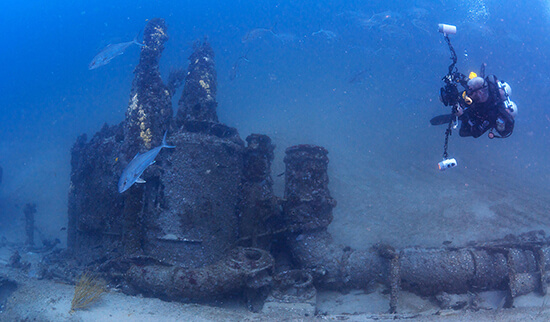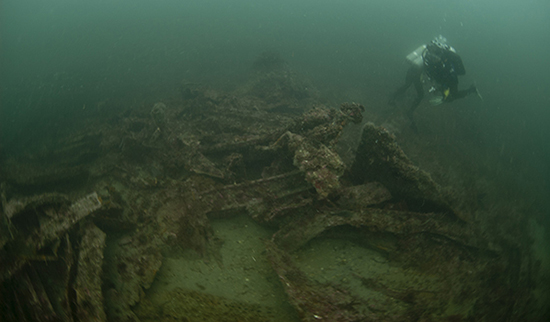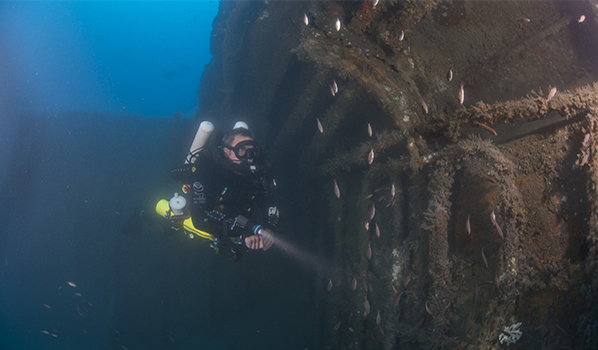
North Carolina's waters have entombed thousands of vessels and countless mariners who lost a desperate struggle against the forces of war, piracy and nature. The rich maritime heritage of coastal North Carolina runs deep with a vast array of shipwrecks. While the area is well known for shipwrecks dating from the Age of North American exploration to present day, the most prominent collection of shipwrecks and time period represented is from World War II's Battle of the Atlantic. This area off North Carolina's coast is where the war came home to the continental United States.
Since 2008, NOAA and its partners, with the assistance of local divers, avocational researchers, and the fishing community, have worked to document these shipwrecks. Click on the links below and learn more about each ship.
To learn more about how NOAA works to preserve our nation’s maritime heritage, download the free curriculum guide Maritime Archaeology: Discovering and Exploring Shipwrecks.
Read an overview of North Carolina's maritime cultural landscape and learn more about existing laws that protect our cultural heritage.

June 2018 marked the start of the 100th anniversary of World War I off the North Carolina coast. To honor the anniversary and the men who fought and died during World War I off our shore, Monitor National Marine Sanctuary actively conducts research on World War I and the ships that sank off our coast. Visit our World War I webpage to learn the history, discover the shipwrecks, and visit often as new data and images are added. If you want to dive a little deeper, click here to read the full document, The Enemy in Home Waters—How World War I Came Home to North Carolina.
Download a free curriculum guide, World War I: Discovering and Exploring the Great War off the North Carolina Coast for students in grades 6-12.
Click here to request more information on these shipwrecks or future maritime heritage projects.

From January through July of 1942, German U-boats sank ships off the American east coast with relative impunity. This American Theatre of World War II was the closest area of conflict to the continental United States. This complex naval battlefield stretched from New England into the Gulf of Mexico, but the area off Cape Hatteras, North Carolina, emerged as a strategic hotspot for this activity and the resulting concentration of shipwrecks is unparalleled in the nation. In just three years, from 1942 to 1945, 90 ships were lost off North Carolina alone as a result of this action. The result is an amazing collection of 78 merchant tankers and freighters, eight Allied warships, and four German U-boats resting on the seabed as a memorial to this history and to the sacrifice of Allied servicemen and the U.S. Merchant Marine in World War II. Explore each shipwreck to learn more about World War II off the North Carolina Coast.
Download a free curriculum guide, Battle of the Atlantic: Discovering and Exploring When the War Came Home, for students in grades 6-12.
Dive slates include the wreck's location, historic vessel information, a site plan identifying the wreck's construction features and the marine life most commonly seen at the site.
Site plans are archaeological drawings created from data collected during an expedition to a shipwreck site.
Below are some of the various shipwrecks NOAA and its partners have surveyed. Enjoy exploring and check back often as new ships are added.
U.S. Navy Virginia-class battleship sunk on September 5, 1923, during aerial bombing tests
The ex-USS Virginia, the lead ship of its class, participated in the Great White Fleet's around-the-world cruise from 1907 to 1909.
1900 oil tanker lost on December 1, 1927, during a heavy gale and used for target practice in 1929 by U.S. Army.
1923 freighter owned by a Swedish Company that ran aground and sunk on September 23, 1929.
Converted 1927 French fishing trawler sunk in a colllision with USS Semmes on May 6, 1942.